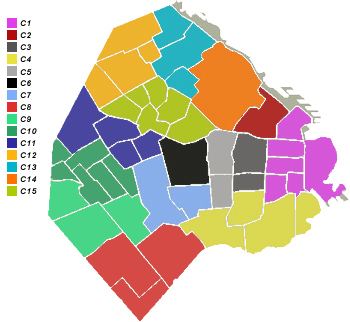 | ||
The city of Buenos Aires is administratively divided into fifteen comunas, unlike the rest of Argentina where the second order administrative division is departamentos, or the Province of Buenos Aires which is subdivided into partidos. Each comuna (commune) of the city encompasses one or more neighbourhoods (barrios), which are represented in the respective community centres for administrative purposes.
The division by comuna was instituted by the 1996 Constitution of the City of Buenos Aires and modified in 2005 by Law #1777. The law was again modified in 2008, 2011, and 2013
The comuna are serially numbered. They are listed below in numerical order together with their constituent neighbourhoods.
- Comuna 1: Puerto Madero, San Nicolás, Retiro, Monserrat, San Telmo, and Constitución
- Comuna 2: Recoleta
- Comuna 3: Balvanera and San Cristóbal
- Comuna 4: La Boca, Barracas, Parque Patricios, and Nueva Pompeya
- Comuna 5: Almagro and Boedo
- Comuna 6: Caballito
- Comuna 7: Flores and Parque Chacabuco
- Comuna 8: Villa Soldati, Villa Lugano, and Villa Riachuelo
- Comuna 9: Parque Avellaneda, Mataderos, and Liniers
- Comuna 10: Villa Luro, Vélez Sársfield, Floresta, Monte Castro, Villa Real, and Versalles
- Comuna 11: Villa Devoto, Villa del Parque, Villa Santa Rita, and Villa General Mitre
- Comuna 12: Villa Pueyrredón, Villa Urquiza, Coghlan, and Saavedra
- Comuna 13: Núñez, Belgrano, and Colegiales
- Comuna 14: Palermo
- Comuna 15: Villa Ortúzar, Chacarita, Villa Crespo, La Paternal, Agronomía and Parque Chas.
References
Communes of Buenos Aires Wikipedia(Text) CC BY-SA
